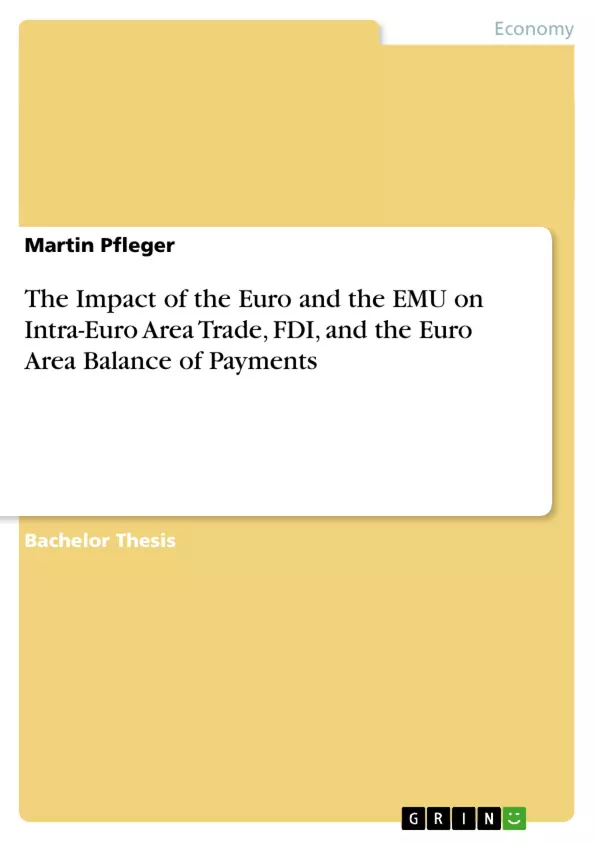Although the Euro has already been introduced as an official currency more than 10
years ago, the opinions of its effects so far and its future implications on the
participating countries still vary dramatically. In this study, the author analyzes the
effects of the Euro and the European Monetary Union on intra-Euro area trade,
foreign direct investment inflows into the Euro area, and the balance of payments of
the 11 original Euro member countries. This paper starts with an investigation of the
historical development of the Euro and the European Monetary Union and an
explanation of the terms intra European trade, foreign direct investment, and the
balance of payments. By comparing results from prior literature and using data from
international institutions, the results show that intra Euro area trade and foreign direct
investment inflows into the Euro area have increased and that the Euro area balance
of payments is developing towards less surpluses and perhaps even deficits on the
current account. On the basis of these findings, the author reasons that the Euro
area has become a more attractive place in which to invest which eventually may
lead to constant future current account deficits of the Euro area.
Inhaltsverzeichnis (Table of Contents)
- 1 Introduction
- 1.1 Research Aim and Research Question
- 1.2 Limitations
- 1.3 Methodology
- 1.4 Chapter Outline
- 2 Theoretical Foundation
- 2.1 The Euro and the European Monetary Union
- 2.1.1 History of European Currencies
- 2.1.2 Development of the European Monetary Union
- 2.2 Intra European Trade
- 2.3 Foreign Direct Investment
- 2.3.1 Reasons for Foreign Direct Investment
- 2.3.2 Factors Affecting Foreign Direct Investment
- 2.3.3 Effects of Foreign Direct Investment on a Host Country
- 2.3.4 Costs and Benefits of Foreign Direct Investment to a Host Country
- 2.4 Balance of Payments
- 2.4.1 Current Account
- 2.4.2 Financial Account
- 2.4.3 Overall Balance
- 2.4.4 Indications of the Balance of Payments
- 2.1 The Euro and the European Monetary Union
- 3 Impact of the European Monetary Union
- 3.1 Impact on Intra Euro Area Trade
- 3.2 Impact on Foreign Direct Investment
- 3.3 Impact on the Component Parts of the Balance of Payments
- 4 Analysis
Zielsetzung und Themenschwerpunkte (Objectives and Key Themes)
This paper examines the impact of the Euro and the European Monetary Union (EMU) on intra-Euro area trade, foreign direct investment (FDI), and the Euro area balance of payments. It aims to understand the influence of the single currency on these key economic indicators and the implications for member states. * The historical development of European currencies and the formation of the EMU. * The theoretical and empirical impact of the Euro on trade flows between Eurozone members. * The impact of the Euro on FDI inflows and outflows within the Eurozone. * The impact of the Euro on the Eurozone's overall balance of payments, including current account and financial account balances. * The analysis of key factors driving changes in trade, FDI, and the balance of payments in the context of the Euro's adoption.Zusammenfassung der Kapitel (Chapter Summaries)
- Chapter 1 introduces the research aim and question, which is to analyze the impact of the Euro and the EMU on intra-Euro area trade, FDI, and the Euro area balance of payments. It also outlines the limitations of the study and the methodology used.
- Chapter 2 provides a theoretical foundation by exploring the Euro and the EMU, including the historical development of European currencies and the rationale behind the creation of the single currency. It then discusses key concepts related to intra-European trade, FDI, and the balance of payments.
- Chapter 3 examines the impact of the EMU on intra-Euro area trade, FDI, and the Euro area balance of payments. It analyzes the effects of the single currency on these economic indicators and discusses potential factors driving the observed changes.
- Chapter 4 provides an analysis of the findings presented in previous chapters, drawing conclusions and highlighting key insights gained from the research.
Schlüsselwörter (Keywords)
This study focuses on the economic effects of the Euro and the European Monetary Union, specifically its impact on trade, foreign direct investment, and the balance of payments within the Eurozone. Key terms and concepts include the Euro, European Monetary Union, intra-Euro area trade, foreign direct investment, balance of payments, current account, financial account, economic integration, and currency union.- Citation du texte
- Martin Pfleger (Auteur), 2010, The Impact of the Euro and the EMU on Intra-Euro Area Trade, FDI, and the Euro Area Balance of Payments, Munich, GRIN Verlag, https://www.grin.com/document/152575



